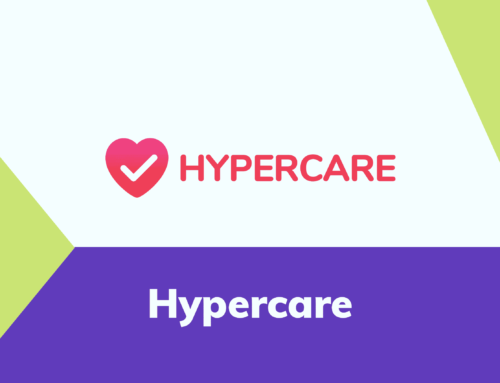Gabriel Mecklenburg, Hinge Health, on nailing product market fit in the employer health market
In this episode of The Pulse Podcast, we interview Gabriel Mecklenburg, President and Co-Founder of Hinge Health, the leading musculoskeletal (also known as MSK) solution for employers and health plans. We discuss Hinge Health’s journey from the early days for Gabriel and Daniel and finding product market fit to growing the business by more than 4X in the last year.
Gabriel is originally from Germany and graduated top of his class in Materials Science at Cambridge and went on to research regenerative medicine and earn his master of philosophy in bioengineering at Imperial College of London.
In 2015, Gabriel and Daniel Perez founded Hinge Health, the first Digital MSK Clinic for back and joint pain at every stage from prevention to post-surgery. Today, 4 in 5 employers with a digital MSK solution partners with Hinge Health. Hinge Health has raised $300M in their latest Series D round in early January of 2021, and is now valued at $3B. Their investors include Atomico, Coatue Management, Tiger Global and Bessemer Venture Partners.
Start — 08:00: Gabriel’s early entrepreneurial journey
Early curiosity around the dinner table: Gabriel wanted to be a scientist growing up with both of his parents having PhDs in physics — there was a lot of discussion around the dinner table about the way the world works. A lot of what Gabriel derived from entrepreneurship was what he hoped to get out of science, which was solving big problems, experimenting and pushing forward the boundary of what we know and what we can do.
Facing a musculoskeletal injury and the journey for a better recovery: While studying Materials Science at Cambridge, Gabriel learned how materials engineering can be used to change the way we treat certain medical conditions. At the same time, he tore his ACL during a judo sparring session. He started researching how musculoskeletal injuries were treated at the Imperial College in London, with a focus on using new material science approaches to develop new types of implants to better treat musculoskeletal injuries.
Testing ventures with the same co-founder: Gabriel had been working with his co-founder, Daniel Perez, CEO of Hinge Health for about nine and a half years now, with Hinge being their third venture together.
The Oxbridge Biotech Roundtable: Their first venture was based in London, with a mission on bridging the gap between academia and industry in life sciences and getting ideas out of the academic sphere.
Marblar: Their second venture, also based in London, was a VC-backed crowdsourcing product development platform to tackle under-addressed healthcare challenges. They grew to 20 to 30 thousand participants but ultimately, they couldn’t find the right way to actually build a business model.
Hinge Health: Last but not least, their third and most successful venture born out of both of their personal histories with musculoskeletal injuries and discovering the massive market opportunity. Their journey together is a true testament to entrepreneurial grit.
The importance of finding a complementary co-founder:
“That’s one of the key ingredients in the secret sauce that helped us get to the place that it is today, which is, we’re both very different people, very complimentary in our approaches. He’s very much the visionary leader archetype …and I consider myself to be much more of the builder and manager archetype”
Daniel, the Visionary leader archetype: Gabriel shares that Daniel has the ability to see what’s coming around the corner and create a vision to rally the company around to get early customers onboard, to get investors excited about the future of Hinge Health.
Gabriel, the Builder and Manager archetype: As a complementary leader, Gabriel shares that he has been internally focused over the years, building out their operations and R&D team, and scaling and maintaining high performance as the company grows from 190 to 600 people over the last year. Gabriel is excited about the challenge of getting hundreds of people together into a system that actually operates effectively towards a goal that they set.
08:00–14:00: Hinge Health’s early days
What are Hinge Health’s offerings? Hinge Health is a full continuum digital clinic for back and joint pain conditions. The goal is to be the primary touch point for any patient with a musculoskeletal injury and for Hinge Health to be able to solve them in a way that is more cost effective, more engaging, and produces better clinical outcomes than the status quo. Today, they have dedicated programs around prevention and wellness, acute injuries, management of chronic pain conditions, as well as pre- and post- surgical rehabilitation.
“Underpinning our clinic is a combination of hardware and software technology and targeted human interventions to deliver this care in a much more scalable and effective way than it is possible right now.”
Digital health in 2014: Hinge Health came into the picture during a very interesting inflection point in the evolution of digital health solutions. Early digital health players like Livongo started blazing the trail and demonstrating outcomes that can be driven using technology and remote coaching.
MSK landscape in 2014: Before Hinge Health, musculoskeletal health was delivered the same way for 30 to 40 years — through surgery, pain medication and physical therapy. Gabriel went through this experience himself through nine months of rehab and physical therapy. The process was outdated: Gabriel’s physical therapist would go through a piece of paper together and do exercises based on a piece of paper, which was not a terribly engaging or effective way of receiving care. Difficulty scheduling and traveling to an appointment added onto the access and cost barriers. There was an untapped greenfield opportunity during that time when nobody had really tackled musculoskeletal health despite the fact that back and joint pain conditions make up one in six healthcare dollars spent in the US.
Product discovery and choosing to build in the U.S.: At first they started in the UK and tried testing different markets, including selling to athletes as a preventive tool. Customer focused, Gabriel and Daniel would be hanging out at running meets, learning from their future customers. Early on, they also explored many different GTM paths such as selling directly to consumers or even bundling surgical implants and partnering with pharma companies. They found their winning GTM strategy when they realized it was a lot easier to schedule a meeting with Execs at Fortune 500 companies based in the US compared with the UK. They were setting up meetings with the Head of Benefits of Lowe’s remotely from London, there was probably something in the US market. At that very moment, Hinge Health started reaching product market fit when they were getting a lot of interest from large self insured employers.
Early sales journey in selling to employers: Gabriel shares the hard truth about early sales in B2B context. In the early days, sales takes a ton of perseverance. The most difficult part was not getting the first meeting, it was closing and converting the sale. One time he had to follow the head of benefits to their taxi!
“You have to do the uncomfortable thing as a founder and just put yourself out there and hear ninety nine No’s from people until you hear that one Yes.”
How applicable is it to the spectrum of employers? MSK benefits are universal to employers. It applies to your more deskbound employees at SalesForce as well as your more mobile employees in warehouses at US Foods. Hinge’s customers span the gamut all the way from younger tech companies to very traditional blue collar workforces across the US.
14:00–19:00 How is Hinge differentiated?
Hinge Health’s flagship chronic condition management is made up of 3 components:
The self-serve mobile app makes it convenient for patients to asynchronously receive care based on their personalized schedules.
The wearable motion sensors are really important to give people the sense of confidence that they’re doing things right, and that they’re actually being taken care of, making the program more tangible, and building credibility with their patients. During their physical therapy exercises, the wearable motion sensors track the movement of the body in three dimensions and give them real time instructions and feedback.
The human elements, coaches and physical therapists ensure the patient knows there is a real person on the other end. Hinge’s clinical team is 10x the size of their competitors and that’s very intentional. Building a relationship with the patient is a huge component of how Hinge Health is able to drive engagement. Some of the people that become the most expensive for the healthcare system benefit the most from the human touch. A lot of Hinge Health’s investment in technology isn’t just focused on the patient experience but the technology that helps a single coach effectively manage relationships with a large number of patients without sacrificing the quality of the interaction. A lot of the automation is meant to take a lot of the cognitive load of the humans and help them do what they do best: investing in the relationship. Hinge Health has really seen strong ROI from this investment, allowing them to maintain 100% customer retention over the last six years.
19:00–21:00 Hinge health has helped employers avoid two out of three elective surgeries
Many of the surgeries are solely conducted at the discretion of the surgeon because there isn’t an FDA process for approving a new surgery, which leads to a lot of inappropriate surgeries. Gabriel shares a shocking study based on randomized control trials where they compared the outcomes in elective surgeries and sham surgeries. Surprisingly, studies showed that the patients had the same clinical outcomes from sham surgery compared with the outcomes from a spinal fusion for chronic chronic back pain or a knee arthroscopy for chronic knee pain. Despite this fact, there are still a half a million knee arthroscopies carried out every year in the US.
Hinge Health is helping to prevent these procedures by forming a trust-based relationship with a participant and providing education around the benefits and disadvantages of different treatment options. One piece is helping them avoid unnecessary procedures and the second piece is helping them reduce their pain to the extent that their desire for surgery goes away.
21:00–23:00 Future of Hinge
2020 was a big year for Hinge Health: In 2020, Hinge Health raised two rounds of venture funding, a testament to their 4X growth. In 2020 alone, Hinge Health has grown the company from about 190 to 600 people.
What’s next in 2021 and beyond? Musculoskeletal health is a $300B market, and they have just barely scratched the surface. They are looking to set themselves up to grow their revenue and patient counts at a rate of 3X. Over the next two years, Gabriel shares that they are expecting the number of employers that offer a digital MSK solution to triple based on research done by third parties. Moving forward, they are looking to grow in adjacent markets beyond large employers, expand their continuum of care and roll out their programs for prevention, expert medical opinions and many other exciting products.
23:00–27:00: Advice to first time healthcare entrepreneurs
Focus on the market before investing time in building a product: Gabriel advises healthcare entrepreneurs to focus on the market before investing in building the product. He shares that in the first company that they started, they were super excited about building a product with a lot of engagement. But they completely ignored that they also needed a business model along with it, and actual customers that would buy the product. Gabriel admits to personally investing a ton of energy into building something that he was proud of, without understanding whether anybody would actually use or buy it. A couple times they literally hacked together a product together in 4 weeks and went live with real users and got really good feedback.
“If the market needs and the user needs are real enough, the product can be totally garbage. There are a lot of ways you can ship something that you’re really embarrassed by other people using. But, if the need is real enough, people will still use it. And that tells you a lot.”
Read from the original source: Medium.com





Posted by
Marta Hi! I'm Marta, project manager for Luminary Chiefs. Here to help, post and make sure everything looks great for you.